Raspberries are grown across Europe: from the sunny Mediterranean to the cool climates of Scandinavia. Their red and pink berries are a visual delight – even a small raspberry patch can enhance any garden or backyard. Among the many varieties, gardeners particularly favor early and ultra-early raspberries, which yield fruit by mid-summer. These berries are perfect for preserves or fresh consumption. Let’s explore the best early raspberry varieties, their advantages, and unique features.
Table of contents
Best Early Raspberry Varieties
Raspberry varieties differ in taste, fruit size, and ripening time. Some berries are prized for their sweet flesh, while others offer a refreshing tartness. Larger fruits are often found in markets, while smaller ones are ideal for jams and desserts.
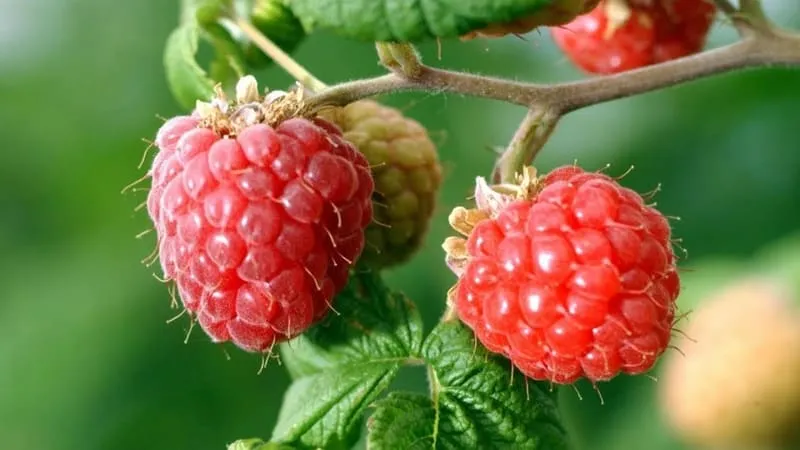
Large-Fruited Varieties
Big, juicy raspberries are a garden highlight. Their fruits can weigh up to 10-12 g and boast excellent marketability.
Heritage
The berries are large, weighing 8-14 g, with a conical, slightly elongated shape. The flesh is aromatic, sweet-tart, with a pleasant aftertaste. The berries are deep red with slight fuzz. A single bush yields up to 8 kg per season. The plant is medium-sized, reaching up to 2 m. Heritage is prized not only for its large berries but also for being thornless – no scratches during harvest! It’s disease-resistant, immune to powdery mildew, and hardy enough for cooler climates.
Glen Ample
Tall, sturdy bushes up to 2 m, with a tree-like form. Many gardeners plant this variety as an ornamental feature. Berries weigh up to 10 g, with juicy, sweet flesh and a pinkish-red hue. The fruits are transportable and versatile – great fresh or processed. Gardeners use them in baking, jams, and liqueurs. Yield ranges from 7-12 kg per plant. Glen Ample is drought-tolerant but has moderate frost resistance.
Malling Jewel
An early, low-maintenance variety. The upright bush grows up to 2.5 m, with flexible, moderately thorny stems and light-green leaves. Berries weigh 7-10 g, with firm, sweet flesh. Ideal for fresh eating or cooking. Yield reaches 13 kg per bush. Malling Jewel has strong disease resistance and is grown both privately and commercially.
Sweetest Early Raspberries
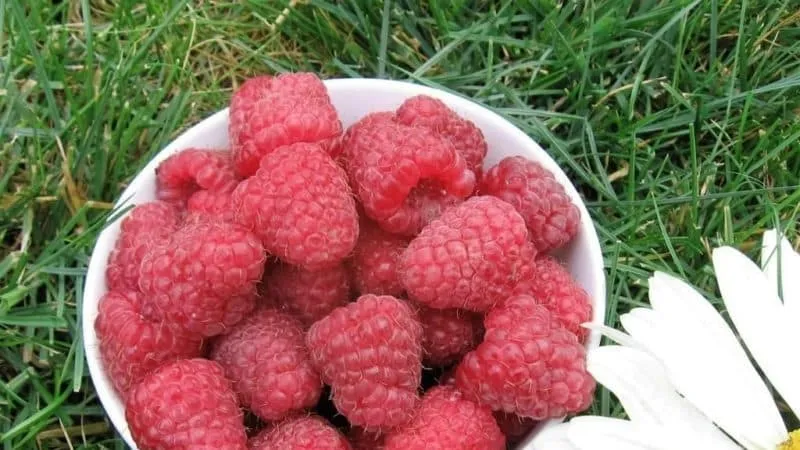
Sweet, fragrant raspberries are perfect fresh or mashed with sugar for tea. With proper care, harvest begins in June–July. Regular watering, feeding, and pruning are key.
Tulameen
A remontant variety with universal use. Moderate thorns, waxy stems, and no fuzz. Berries weigh 4-8 g, with bright red color and juicy, sweet flesh reminiscent of wild raspberries. Taste rating: 4.6/5. Moderate drought resistance and standard pest immunity. Yield: up to 5 kg per plant. Fruits retain quality during transport and don’t drop prematurely. They can be stored for a month post-harvest.
Autumn Bliss
Winter-hardy and low-maintenance, Autumn Bliss thrives even in unstable climates. Upright, semi-spreading bushes reach 2.2 m, with minimal thorns and branching stems. Fruits ripen by early or mid-June. Berries weigh ~3 g, with a rich ruby color and conical shape. The taste is balanced – sweet with a refreshing finish. Delicate flesh with small seeds. Ripe berries don’t crack or drop, making them transport-friendly.
Joan J
A beloved variety grown for over 30 years. Upright bushes up to 1.8 m, with medium-sized, slightly wrinkled leaves and waxy stems. In temperate Europe, Joan J fruits in early to mid-June. Berries weigh 5-12 g, with a velvety red surface and conical shape. The tender flesh melts in the mouth, offering a sweet, aromatic flavor. Yield: ~5 kg per bush. Best eaten fresh or processed immediately – not suited for storage.
Note: Raspberries love moisture – drought causes leaf wilt and stunted fruit. If watering is adequate but bushes still dry, check for raspberry gall midge. This pest lays larvae that devour plants. Remove and burn infected stems.
Non-Remontant (Floricane) Raspberries
These varieties fruit once per year, requiring minimal care while delivering reliable yields.
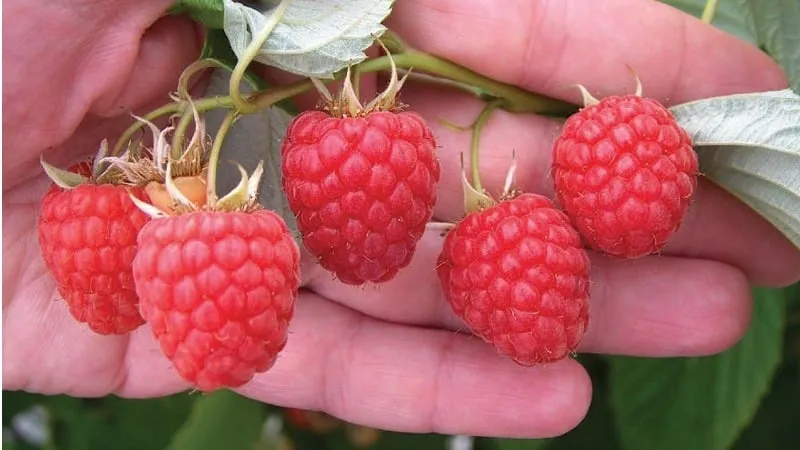
Glen Moy
An early, cold-hardy variety recommended for Central Europe. Resistant to fungal diseases. Yield: 3-5 kg per season. Compact bushes (~2 m) with short, thin thorns and large leaves. Berries weigh ~3 g, blunt-conical, and red. Sweet-tart flesh scores 4.1/5. Glen Moy resists spider mites and leaf spot, transports well, and is versatile in use.
All Gold
Medium-sized, slightly spreading bushes with few thorns. Berries are round-conical, golden-apricot, with a sweet-tart taste and delicate flesh. Average weight: 2.5 g. All Gold is prized for its unique color and easy cultivation. Not suitable for transport – berries crack and lose quality.
Polka
Large, sweet berries weighing 10-15 g, elongated-conical, deep red. Firm texture retains shape post-harvest. Easy to pick. Bushes reach 2 m with sturdy stems. Fruiting lasts from late June to early August. Ideal fresh, cooked, or dried. Annual yield: ~5 kg.
Remontant (Everbearing) Varieties
These high-yield plants fruit multiple times yearly, often with large, sweet berries.
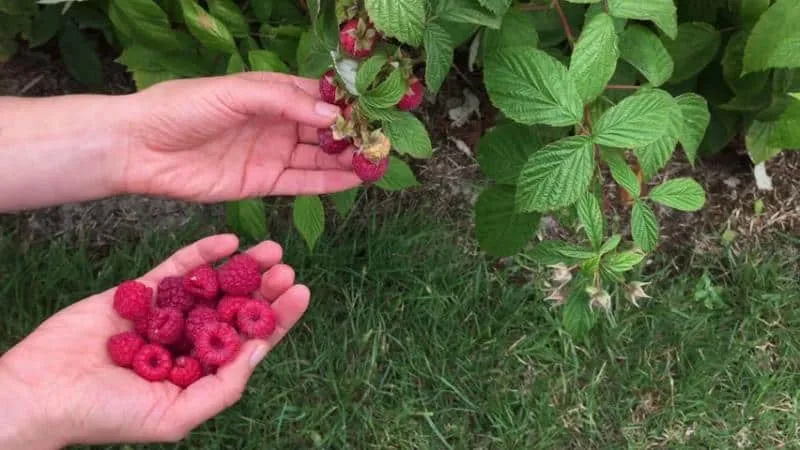
Polka
Compact, tree-like bushes up to 1.3 m. Light-brown stems with moderate thorns. Berries weigh 4-6 g, broad-conical, dark red, slightly fuzzy. Sweet-tart flesh, no aroma. Yield: up to 15 kg/year. Disease-resistant and low-maintenance. Berries don’t drop, making them transport-friendly.
Autumn Treasure
Attractive, uniform red berries (~4 g). Firm, sweet flesh. Yield: ~1 kg/bush over 1-3 months. Flexible stems support heavy fruiting without breaking. Post-harvest, berries resist rot. Disease-resistant and versatile. Medium-sized, semi-spreading bushes with minimal thorns.
Himbo Top
A universal variety with frost resistance down to -35°C. Large berries (7-10 g), conical or truncated, glossy red. Balanced sweet-tart taste. Yield: 4-5 kg/bush. For best flavor, plant in sunny spots – shade reduces quality.
Note: During fruiting, remontant raspberries need ample water. Water mornings/evenings to avoid sunburn, using room-temperature water. To prevent mildew or gray mold, spray with Bordeaux mixture or copper sulfate solution.
Ultra-Early Raspberry Varieties
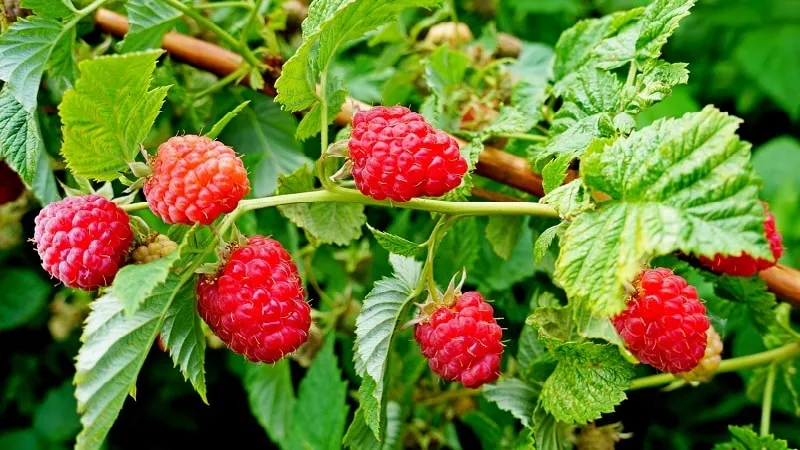
These varieties transport well, making them ideal for sale. A popular choice is Glen Coe. Recommended for Central and Northern Europe. Vigorous, spreading bushes with straight thorns and sturdy stems. Berries weigh ~3.2 g, blunt-conical, red. Sweet-tart taste, rich aroma (rating: 4.2/5). Retains flavor when cooked or preserved.
Another ultra-early variety is Valentina. Resistant to gall midge and fungal diseases. Berries ripen uniformly and don’t drop. Semi-spreading bushes (~1.5 m) with soft thorns. Small berries (1-2 g), purple, blunt-conical. Sweet-tart taste (3.5/5). Grown widely in cooler regions.
Early Surprise Raspberry Overview
This well-known variety attracts gardeners with its rapid ripening, appearance, and easy care.
Appearance
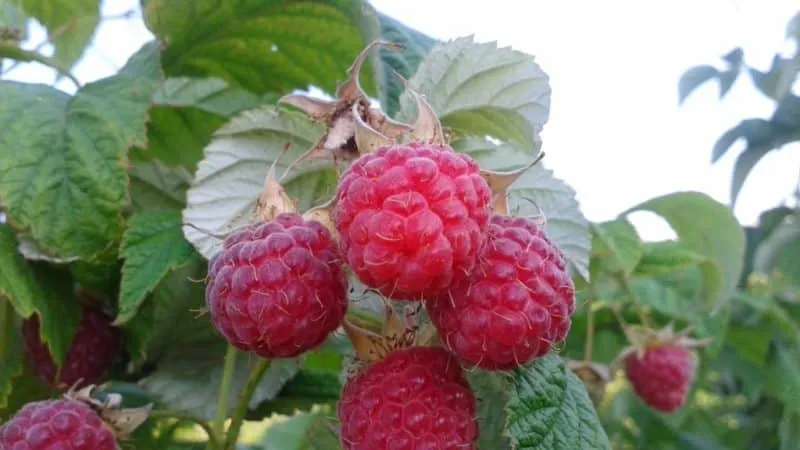
Medium-sized bushes (1.8-2 m) with strong shoot growth, straight stems, and a waxy coating. Numerous short black thorns, medium flowers, and dark-green wrinkled leaves. Berries weigh 2-4 g, elongated-conical, dark red. Firm, sweet-tart flesh.
Characteristics
Early Surprise is self-fertile, fruiting by late June. Moderate frost resistance – winter mulching is advised. Not ideal for transport; best eaten fresh or processed. Rarely diseased, ensuring abundant harvests.
Growing Tips
Soil matters – Early Surprise thrives in neutral to slightly acidic earth. Choose sunny, well-dug sites enriched with organic matter. Avoid planting after tomatoes, potatoes, or strawberries – shared diseases increase infection risks.
Prune several times yearly: shorten old canes, remove suckers. Trim fruiting stems by 20-25 cm post-planting. Pruning boosts productivity and deters pests. Weeding and mulching maintain healthy soil ecology.
Note: In spring, feed Early Surprise with manure tea (1:10 ratio). Established beds benefit from nitrogen-rich mineral fertilizers pre-tilling. In late summer, apply wood ash – this sweetens next year’s berries.
Conclusion
Heritage and Glen Ample impress with berry size (up to 14 g), while Joan J and Tulameen delight with flavor. For ultra-early harvests, consider Glen Coe or Valentina – transport-friendly, reliable, and easy-care. Early Surprise is another standout: self-fertile, high-yielding, and delicious.







